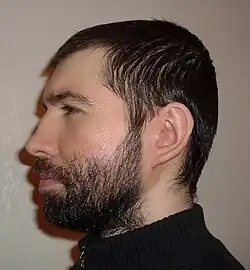Dmitry Borshch
Dmitry Gennadievich Borshch (Russian: Дмитрий Геннадиевич Борщ) is a Russian-American artist known for his minimalistic, surrealist style. He has drawn portraits of several notable figures, including Henry Kissinger and Ed Koch.

Early life
Borshch was born in Dnipropetrovsk, Ukraine, and studied in Moscow.[1] Borshch described Dnipropetrovsk and Soviet Moscow as "bleak", with his background in the countries playing a role in his work.[2] In 1989, Borshch fled to the United States as a political refugee due to turmoil within the Soviet Union. He currently lives in New York,[3] and describes himself as American or Russian-American.[2]
.jpg)
Career
Borshch is known for his minimalistic artwork, which have been interpreted as a homage to Soviet paradigms. Borshch accepts labelling his work as "Soviet nonconformist pictures", stating, "I would accept the label. USSR is no more but my art still lives there, 'nonconforming' to the state's cultural dictates and proscriptions."[4] Borshch typically draws in blue ink against a white background, however has on occasion used different colors, such as red ink in Odalisque, currently in the collection of the Museum of Modern Art.[2] His works have been exhibited at the Russian Cultural Center, HIAS, the Lydia Schukina Institute of Psychology in Moscow, and the Museums of Contemporary Art in Poltava and Lviv.[5]
Works

One of Borshch's most recognizable works is "Bush-Maliki News Conference. Baghdad, December 2008", a drawing of the George W. Bush shoe-throwing incident that has been exhibited at the Institute of Oriental Studies of the Russian Academy of Sciences, DePaul University, Brecht Forum and is included in the Catalog of American Portraits, maintained by the Smithsonian's National Portrait Gallery.[6][7][8]
References
- ^ "Dmitry Borshch". Long Con Magazine. Archived from the original on August 6, 2022. Retrieved December 19, 2024.
- ^ a b c Shekhtman, Anastasiya. "EXILED FROM TRUTH: NINE ALLEGORIES". Cleaver Magazine. Archived from the original on September 8, 2024. Retrieved December 19, 2024.
- ^ "Dmitry Borshch". America-Israel Cultural Foundation. Archived from the original on June 23, 2024. Retrieved December 19, 2024.
- ^ Koblyakova, Masha (July 28, 2017). "A Russian Artist Reimagines the World in Bold Blue Ink". Vice. Archived from the original on September 3, 2024. Retrieved December 19, 2024.
- ^ "Dmitry Borshch". The Russian American Cultural Center. Archived from the original on September 20, 2024. Retrieved December 19, 2024.
- ^ "Dmitry Borshch, Catalog of American Portraits (CAP), National Portrait Gallery, Smithsonian Institution". August 21, 2015. Archived from the original on January 26, 2016. Retrieved December 20, 2024.
- ^ "Literary scholar John Maynard and artist Dmitry Borshch in conversation on art, Russian American Cultural Center on Artsy". February 27, 2014. Archived from the original on February 8, 2015. Retrieved December 20, 2024.
- ^ "Saatchi Gallery, Russian American Cultural Center Of New York". Archived from the original on February 8, 2015. Retrieved December 20, 2024.